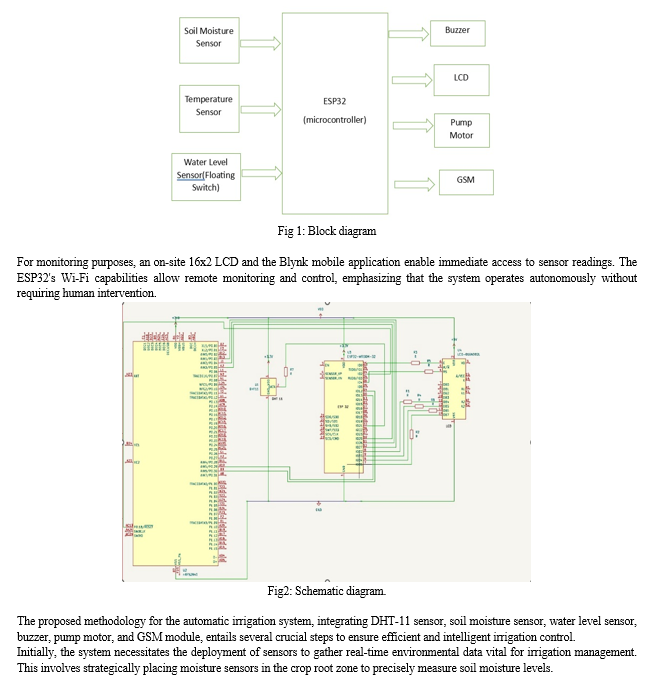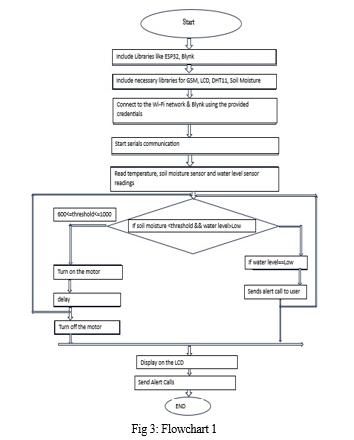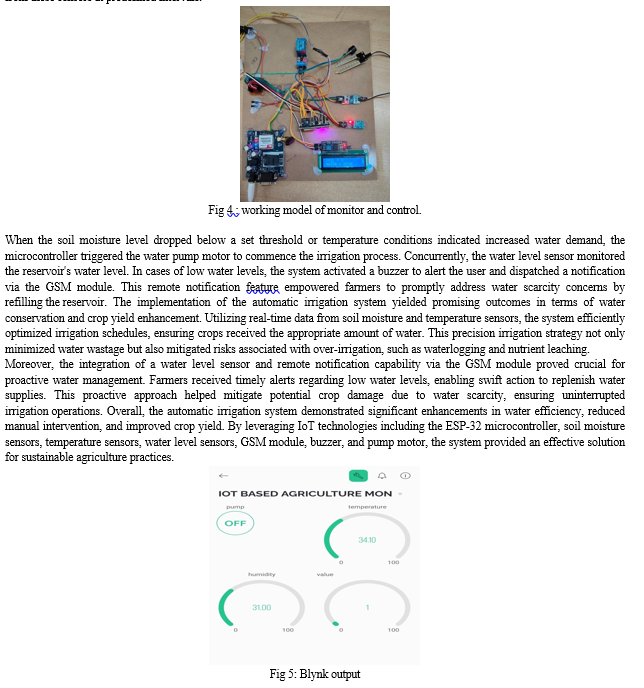Ijraset Journal For Research in Applied Science and Engineering Technology
- Home / Ijraset
- On This Page
- Abstract
- Introduction
- Conclusion
- References
- Copyright
Automated Irrigation System Using Temperature Sensor and Soil Humidity Sensor
Authors: Mrs. K Anusha, Maram Amulya, Reshma Begum, Tanisha Sharma
DOI Link: https://doi.org/10.22214/ijraset.2024.63315
Certificate: View Certificate
Abstract
Over recent years, the agricultural sector has experienced a significant shift towards implementing smart farming techniques facilitated by Internet of Things (IoT) technology. This paper introduces the conception, creation, and execution of an automatic irrigation system utilizing an ESP-32 microcontroller, soil moisture sensor, DHT-11 sensor, water level sensor, buzzer, pump motor, and GSM module. The primary objective of this system is to optimize water consumption and augment crop yield by delivering precise irrigation control based on real-time environmental data. The proposed model presents numerous advantages including improved water efficiency, minimized manual intervention, and enhanced crop yield through optimized irrigation techniques. Furthermore, its scalability and adaptability render it suitable for deployment across diverse agricultural environments. Experimental findings affirm the efficacy and dependability of the model in conserving water resources while maximizing agricultural output.
Introduction
I. INTRODUCTION
The emergence of Internet of Things (IoT) technology has sparked a revolution across various industries, with agriculture being no exception. Smart farming, empowered by IoT, presents significant potential in tackling the challenges encountered by the agricultural sector, particularly in optimizing resource utilization and enhancing productivity. Among the critical aspects of modern agriculture, efficient irrigation management stands out, as it profoundly influences crop growth while also conserving water resources. Conventional irrigation techniques often rely on manual oversight and lack customization tailored to specific crop needs or prevailing environmental conditions.
This lack of precision often leads to inefficient water usage, resulting in wastage and potential crop harm due to inadequate or excessive irrigation. To confront these issues, automated irrigation systems have emerged as promising solutions, offering precise control over irrigation schedules based on real-time inputs.
This paper presents the design, development, and implementation of an automatic irrigation system that harnesses advanced IoT technologies. The system integrates vital components such as soil moisture sensor, DHT-11 sensor, water level sensor, buzzer, pump motor, and GSM module, all managed by the ESP-32 microcontroller.
By leveraging these technologies, the proposed system aims to optimize irrigation practices by dynamically adjusting water delivery based on soil moisture content, ambient temperature, and water availability.
The inclusion of a soil moisture sensor facilitates continuous checking of soil moisture levels, enabling the system to trigger irrigation only when necessary. Additionally, the temperature sensor, DHT-11 allows the system to account for temperature fluctuations, which directly affect crop water requirements. Furthermore, a water level sensor ensures the irrigation reservoir maintains sufficient water supply, enhancing the system's efficiency and dependability.
Moreover, to enhance user awareness and enable timely intervention, the system incorporates both a buzzer for audible alerts and a GSM module for remote notifications. These features empower farmers to receive alerts regarding low water levels or system malfunctions, enabling prompt actions to mitigate potential issues.
In summary, the proposed automated irrigation system provides a holistic solution to address challenges associated with conventional irrigation methods. Through the utilization of IoT technologies, the system delivers precise control over irrigation processes, leading to improved water efficiency, enhanced crop yield, and ultimately fostering sustainable agricultural practices. Experimental validation of the system underscores its effectiveness and reliability in real-world agricultural contexts.
II. RELATED WORKS
The IoT is fundamentally reshaping agriculture, offering novel avenues for data-driven decision-making and automation. A pivotal aspect of this transformation lies in precision farming, where IoT sensors gather real-time data on crucial parameters like soil moisture, temperature, humidity, and crop health. This data gives the information into crop conditions, empowering farmers to optimize crucial processes such as irrigation, fertilization, and pest control. With precise monitoring of environmental factors and crop status, farmers can significantly mitigate resource wastage, curtail operational costs, and amplify yields. Moreover, the adoption of IoT in precision agriculture fosters sustainable practices by curbing chemical usage and water consumption, thereby fostering an environmentally conscious and more efficient farming landscape. IoT is also revolutionizing livestock management within agriculture. Utilizing IoT devices like smart ear tags and wearable sensors, farmers can monitor the real-time health, behavior, and location of individual animals. This data enables early detection of illnesses and enhances breeding practices.
Through continuous monitoring of animal welfare and performance metrics, informed decisions by the farmers can be made to optimize feeding schedules, minimize stress, and boost productivity. Additionally, IoT-enabled livestock management systems plays an important role in sustainable farming by streamlining resource utilization and waste management practices, thereby reducing the environmental impact of animal agriculture. In essence, IoT technologies empower farmers with actionable insights and automation tools, driving efficiency, productivity, and sustainability throughout the food production chain.
The research paper titled "GSM based Automated Irrigation Control using Raingun Irrigation System" [1] published in the International Journal of Advanced Research in Computer and Communication Engineering, Volume 3, Issue 2, in February 2014, presents a novel approach to automated irrigation management. By integrating GSM technology with a raingun irrigation system, the authors aim to enhance irrigation efficiency through remote control functionality. This system enables farmers to remotely monitor and regulate irrigation processes, potentially improving convenience and resource utilization. The paper likely delves into the system's design, implementation, and evaluation, discussing its benefits and effectiveness in agricultural irrigation management.
In the paper authored by S.P. Maniraj, Tanya Chaudhary, Akanksha Agarwal, Nandini Kishore, and Vaibhavi Verma, [3] published in the JNCET, Volume 8, Issue 4, in April 2018, is presented. This system integrates soil moisture sensors with an Arduino microcontroller to continuously monitor soil moisture levels and automate irrigation processes accordingly. The paper likely discusses the system's design, implementation, and evaluation, emphasizing its capability to optimize irrigation efficiency by delivering precise control based on real-time soil moisture data.
On the other hand, the paper, published in IEEE Transactions on Instrumentation and Measurement, Volume 63, Issue 1, in January 2014, [4] introduces an "Automated Irrigation System Using a Wireless Sensor Network and GPRS Module." This system employs a wireless sensor network in conjunction with a GPRS module to remotely monitor and manage irrigation processes. It also explores how these technologies enhance efficiency by providing timely data on soil moisture levels, thereby optimizing water usage and taking a step forward for a sustainable development in the field of agriculture. The paper is likely to delve into the system's architectural design, sensor deployment strategies, communication protocols, and the effectiveness of the automatic irrigation system in conserving water resources and augmenting crop yield.
The paper titled "Irrigation Control System Using Android and GSM for Efficient Use of Water and Power," [8] published in the International Journal of Advanced Research in Computer Science and Software Engineering, Volume 4, Issue 7, in July 2014, introduces a novel irrigation control system. This system integrates Android technology with GSM communication to enhance the efficient utilization of water and power in irrigation processes. The paper is expected to delve into the system's design, implementation, and evaluation, highlighting its capacity to optimize irrigation practices through remote control and monitoring via Android devices. By facilitating remote access and control, the system aims to contribute to the conservation of water and power resources in agricultural operations.
The paper authored by Abhinav Rajpal, Sumit Jain, Nistha Khare, and Anil Kumar Shukla, titled "Microcontroller based Automatic Irrigation System with Moisture Sensors," [9] likely discusses an automatic irrigation system that relies on microcontroller technology and moisture sensors. This system is engineered to automate irrigation processes by detecting soil moisture levels and subsequently activating irrigation mechanisms as needed. The publication might provide information on the system's architecture, sensor integration methods, and its effectiveness in conserving water resources while maintaining optimal soil moisture levels essential for crop growth.
This literature survey demonstrates the immense potential of IoT for revolutionizing irrigation management. By leveraging real-time data collection, automated control mechanisms, and innovative system designs, researchers are building the way for a future of efficient, sustainable, and high- yielding agriculture. It is very emerging and easy to use as compared to all the old methodologies.
III. PROPOSED METHODOLOGY
The primary goal is to build an automatic irrigation system utilizing the ESP32 microcontroller. This can be monitored from remote areas and controlled automatically without any human interference. Key sensors, including moisture level detecting sensor and DHT11 sensor, are seamlessly integrated into the system for real-time assessment of temperature, soil mositure and water level.


The above flowchart which is Fig3: flowchart 1 is the logic explaining the overall methodology of the given solution.
Temperature sensors are positioned to monitor ambient temperature variations, which directly impact the water requirements for optimal plant growth. Additionally, a water level sensor is installed in the irrigation reservoir to monitor water availability for irrigation purposes.
Subsequently, the collected data are sent to the ESP-32 microcontroller for processing and decision-making. Serving as the central processing unit, the ESP-32 receives inputs from all the sensors and executes algorithms to determine the irrigation schedule based on predefined thresholds and criteria. For instance, if the soil moisture level drops below a specified threshold or if temperature conditions indicate heightened water demand, the ESP-32 initiates the irrigation process.
The irrigation process is then activated by engaging the water pump motor upon receiving the appropriate signal from the ESP-32. The pump motor draws water from the reservoir and distributes it to the irrigation system, ensuring crops receive sufficient moisture for optimal growth and development.
Moreover, the system incorporates a buzzer to deliver audible alerts in critical conditions such as low water levels in the reservoir. Upon detecting insufficient water, the water level sensor triggers the buzzer via the ESP-32, notifying the user of potential water scarcity issues and prompting timely intervention to replenish the water supply.
Finally, the integration of a GSM module enables remote monitoring and control of the irrigation system. In instances requiring manual intervention or in the event of system malfunctions, the GSM module sends notifications to the user's mobile device, facilitating immediate action. This feature enhances the system's accessibility and reliability, empowering farmers to effectively manage their irrigation systems even from remote locations.
In summary, the proposed methodology harnesses the synergy of sensors, microcontroller, pump motor, buzzer, and GSM module to create an intelligent and automated irrigation system capable of optimizing water usage in agricultural settings.
IV. IMPLEMENTATION & RESULTS:
The implementation of the automated irrigation system centered around the ESP-32 microcontroller serving as the core processing unit. The temperature sensor and the soil moisture sensor were strategically positioned throughout the agricultural field to monitor soil moisture content and ambient temperature levels respectively. Additionally, a water level sensor was put in place in the irrigation reservoir to track the available water supply. The ESP-32 microcontroller was programmed to continuously collect data from these sensors at predefined intervals.

Conclusion
In conclusion, this paper has focused on the design and deployment of an IoT-driven automatic irrigation system leveraging the ESP-32 microcontroller, soil moisture sensor, temperature sensor, water level sensor, buzzer, pump motor, and GSM module. By overcoming the limitations of traditional irrigation methods, this system offers an automated and effective solution to optimize water utilization and enhance crop yield in agriculture. Through continuous monitoring of soil moisture levels and ambient temperature, the system intelligently orchestrates the irrigation schedule, ensuring precise water delivery to crops when required. The incorporation of a water level sensor further bolsters the system\'s reliability by maintaining an ample water supply in the irrigation reservoir. In instances of low water levels, the system promptly alerts the user via a buzzer alarm and GSM module, enabling swift action to avert potential crop damage. The experimental findings validate the efficiency and dependability of the proposed system in conserving water resources and maximizing agricultural output. By minimizing manual intervention and offering remote monitoring capabilities, the system provides farmers with convenience and adaptability, facilitating more efficient management of irrigation operations. In essence, the developed automatic irrigation system signifies a notable advancement in modern agriculture, contributing to sustainable farming practices and ensuring food security. Future endeavors could concentrate on enhancing the system\'s scalability, integrating additional sensors for comprehensive environmental monitoring, and incorporating predictive analytics for anticipatory irrigation scheduling, thereby further enhancing its efficacy and efficiency in agricultural contexts. Through ongoing research and innovation, IoT-based solutions such as the one elucidated in this paper hold promise in revolutionizing agriculture, making it more resource-conscious, environmentally sustainable, and resilient to fluctuating climatic conditions.
References
[1] R. Suresh, S. Gopinath, K. Govindaraju, T. Devika, N. SuthanthiraVanitha, \"GSM-based Automated Irrigation Control using Raingun Irrigation System,\" International Journal of Advanced Research in Computer and Communication Engineering, vol. 3, issue 2, February 2014. [2] Pavithra D.S, M. S. Srinath, \"GSM-based Automation Irrigation Control System for Efficient Resource Use and Crop Planning using Android Mobile,\" IOSR Journal of Mechanical and Civil Engineering (IOSR-JMCE), vol. 11, issue 1, Jul-Aug 2014, pp. 49-55. [3] S.P. Maniraj, Tanya Chaudhary, Akanksha Agarwal, Nandini Kishore, Vaibhavi Verma, \"Irrigation Management System Using Soil Moisture Sensor and Arduino,\" Journal of Network Communications and Emerging Technologies (JNCET), vol. 8, issue 4, April 2018. [4] Joaquín Gutiérrez, Juan Francisco Villa-Medina, Alejandra Nieto-Garibay, Miguel Ángel Porta-Gándara, \"Automated Irrigation System Using Wireless Sensor Network and GPRS Module,\" IEEE Transactions on Instrumentation and Measurement, vol. 63, no. 1, January 2014. [5] N.V. Gowtham Deekshithulu, G. Ravi Babu, R. Ganesh Babu, M. Siva Ramakrishna, \"Development of Software for Microcontroller Based Automated Drip Irrigation System Using Soil Moisture Sensor,\" International Journal of Current Microbiology and Applied Sciences, vol. 7, no. 1, 2018. [6] I. Gautam, S.R.N. Reddy, \"Innovative GSM-Bluetooth Based Remote Controlled Embedded System for Irrigation,\" International Journal of Computer Applications, vol. 47, no. 8, 2012, pp. 1-6. [7] Laxmi Shabadi, Nandini Patil, Nikita M., Shruti J., Smitha P., Swati C., \"Irrigation Control System Using Android and GSM for Efficient Water and Power Use,\" International Journal of Advanced Research in Computer Science and Software Engineering, vol. 4, issue 7, July 2014. [8] Abhinav Rajpal, Sumit Jain, Nistha Khare, Anil Kumar Shukla, \"Microcontroller Based Automatic Irrigation System with Moisture Sensors,\" Proceedings of the International Conference on Science and Engineering, 2011, pp. 94-96. [9] Mahesh M. Galgalikar, Gayatri S. Deshmukh, \"Real-Time Atomization of Irrigation System for Modernizing Indian Agricultural System,\" Proceedings of the International Journal of Computer Applications, vol. 1, 2010.
Copyright
Copyright © 2024 Mrs. K Anusha, Maram Amulya, Reshma Begum, Tanisha Sharma. This is an open access article distributed under the Creative Commons Attribution License, which permits unrestricted use, distribution, and reproduction in any medium, provided the original work is properly cited.

Download Paper
Paper Id : IJRASET63315
Publish Date : 2024-06-16
ISSN : 2321-9653
Publisher Name : IJRASET
DOI Link : Click Here
 Submit Paper Online
Submit Paper Online

